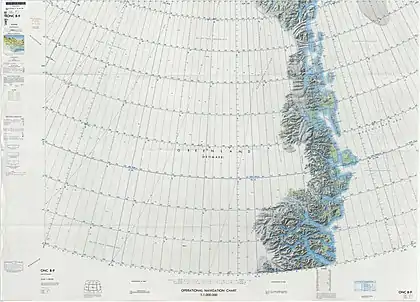Petermann Peak
Petermann Peak,[3] (Danish: Petermann Bjerg),[4] also known as Petermann Fjeld, Petermanns Topp and Petermann Point[2] is a mountain in King Christian X Land, Northeast Greenland. Administratively it is part of the Northeast Greenland National Park zone.
| Petermann Peak | |
|---|---|
| Petermann Bjerg | |
 Petermann Peak | |
| Highest point | |
| Elevation | 2,943 m (9,656 ft)[1] |
| Listing | |
| Coordinates | 73°5′24″N 26°23′25″W[1] |
| Geography | |
| Location | Fraenkel Land, NE Greenland |
| Climbing | |
| First ascent | 1929[2] |
The area around Petermann Peak is uninhabited. This mountain is located in the high Arctic zone, where Polar climate prevails. The average annual temperature in the area is −16 °C. The warmest month is June, when the average temperature rises to −2 °C, and the coldest is January, with −22 °C.[5]
Geography
Petermann Peak rises to a height of 2,943 metres (9,656 ft) on a nunatak located the northern side of the Nordenskiöld Glacier, in western Fraenkel Land in the inner Kaiser Franz Joseph Fjord. It has a magnificent appearance, dominating the surrounding landscape. The Gregory Glacier flows from its northeastern side into the Knækdalen valley.[6] The Kalifbjerg (2667 m), Kerberus (c. 2500 m), Gog (c. 2600 m) and Magog (c. 2400 m) peaks are located to the north of Petermann Peak. Initially believed to be the highest peak in Greenland, this mountain is one of the most renowned summits in northeastern Greenland together with Payer Peak located nearby.
The Petermann Peak is marked as a 9,646-foot-high (2,940 m) peak in the Defense Mapping Agency Greenland Navigation charts[7] and as a 2,790-metre-high (9,154 ft) mountain in other sources.[8]
Historical background
Petermann Peak was first seen in August 1870 by Julius Payer and Ralph Copeland when they climbed Payer Peak. It was named Petermanns Spitze by Carl Koldewey during the Second German North Polar Expedition he led while first surveying and partially exploring Kaiser Franz Joseph Fjord in 1869–70. The peak was named after German geographer August Heinrich Petermann (1822–78) who was a great supporter of the expedition.[2] In 1899 A.G. Nathorst mistook a lower peak in the vicinity, now named Nathorst Tinde, for Petermann Bjerg. At the turn of the century Petermann Peak was assumed to be the highest peak in all Greenland.[9]
The first ascent of the peak was made on 15 August 1929 by the Cambridge Expedition to East Greenland led by Scottish polar explorer James Wordie (1890–1962).[3] the second ascent by John Haller and Wolfgang Diehl on 9 August 1951.[10]
 Representation of the 12 August 1870 discovery of Petermann Peak by Julius Payer, Ralph Copeland and Peter Ellinger after climbing onto Payer Peak. |
 Map of Northeastern Greenland. |
See also
References
- Google Earth
- "Catalogue of place names in northern East Greenland". Geological Survey of Denmark. Retrieved 26 June 2016.
- Wordie, J. M.; Wakefield, R. C.; Whittard, W. F.; Manley, G. (1930). "Cambridge East Greenland Expedition, 1929: Ascent of Petermann Peak". The Geographical Journal. 75 (6): 481–502. doi:10.2307/1784482. JSTOR 1784482.
- "Petermann Bjerg". Mapcarta. Retrieved 26 June 2016.
- "NASA Earth Observations Data Set Index". NASA. Retrieved 26 June 2016.
- Map (PDF; 3,4 MB) von Nordostgrönland im Maßstab 1:1.000.000, De Nationale Geologiske Undersøgelser for Danmark og Grønland (GEUS)
- 1:1,000,000 scale Operational Navigation Chart, Sheet B-9
- Petermann Bjerg. In: Anthony K. Higgins: Exploration history and place names of northern East Greenland. (= Geological Survey of Denmark and Greenland Bulletin 21, 2010). Kopenhagen 2010, ISBN 978-87-7871-292-9
- The Development of Mountaineering in East and North-East Greenland, An Outline History
- Odell, N.E. 1943: Aspects of mountaineering in the high Arctic. Alpine Journal 54, 182–190.